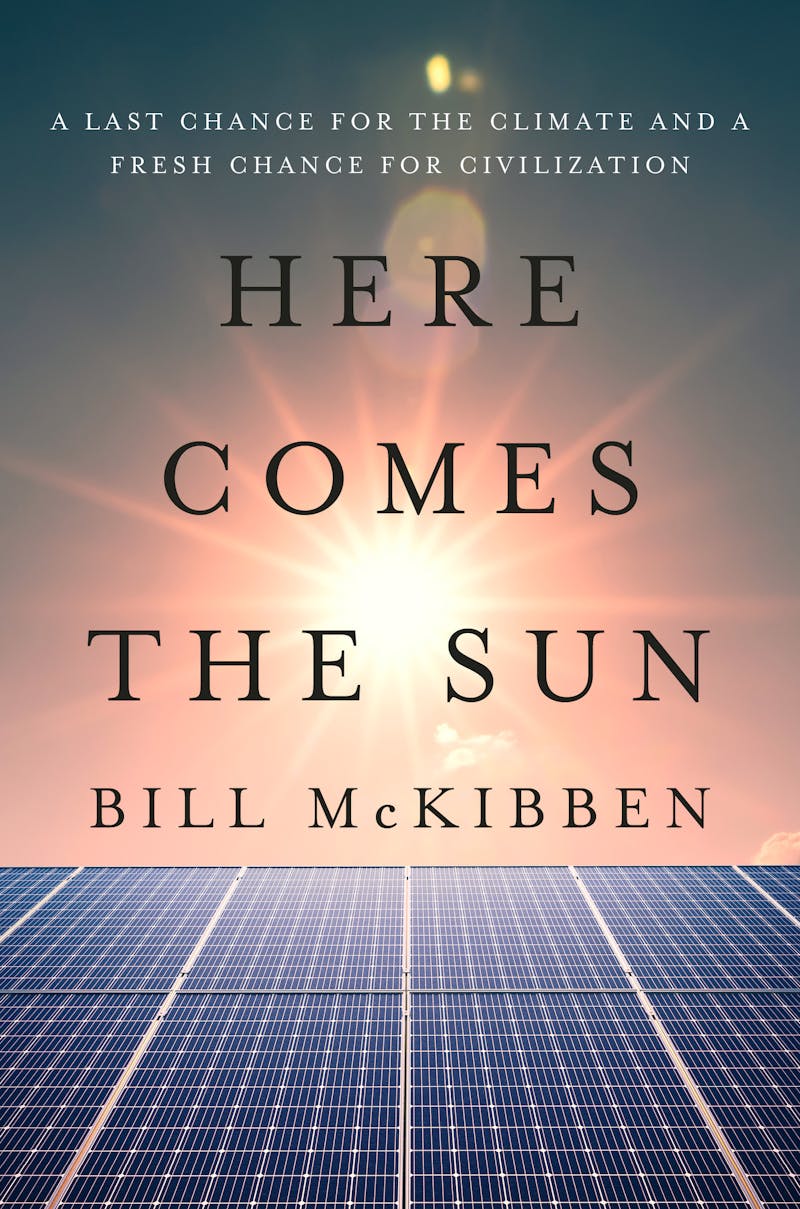The hour on the climate clock has always been late. By the time NASA scientist James Hansen delivered his landmark Senate testimony in 1988, bringing “the greenhouse effect” to public attention for the first time, the atmospheric carbon count had surpassed 350 parts per million, considered the “safe” upper limit to avoid catastrophic climate change. Twenty years later, the count was sailing past 380 when Bill McKibben launched 350.org, a name chosen to bring attention to the urgent task of slowing and possibly reversing the clock’s wildly racing minute hand. Seventeen years after that, the count has struck 430. Beyond midnight metaphors, the climate clock is now deep in a.m. territory, the folkloric hour of the wolf.
McKibben is not one to sugarcoat this. His first book, 1989’s The End of Nature, appeared one year after Hansen’s testimony, inaugurating a career dedicated to reporting the Holocene’s careen into the Anthropocene. After 36 years, millions of words, and several protest-related misdemeanor arrests, he is climate journalism’s elder statesman, sainted to some, whose books serve as temperature checks, strategy documents, and sources of movement funding. Here Comes the Sun, his new survey and defense of solar energy and its scaling potential, fits this mold; McKibben used part of the advance to support an upcoming national day of action called “Sun Day.” The book begins with an acknowledgment of his long-held apprehension that the window for meaningful action may be closed. After decades of covering the science and politics of climate change, he describes the sorry state of things as “the summation and the vindication of all that angst.”

Yet angst is not his register here. The hour of the wolf is associated with nightmares and death, but also with birth and, eventually, dawn. Like the song it’s named after, Here Comes the Sun is a major-key invocation of a salvational sunrise. “Right now, really for the first time,” he writes, “I can see a path forward. A path lit by the sun.”
Neither the sunlit path of a renewable “transition” nor McKibben’s advocacy are new, of course. He has been staking his name and reputation on this transition for the better part of two decades. What’s new is the mix of aggressive offense, scrappy defense, and oversize confidence he brings to it. Here Comes the Sun is the most programmatic of McKibben’s more than 20 books, a collection of good-news headlines and data points arranged to bolster faith in the supposition that we can solarize electricity and electrify the global economy, all without reducing global energy demand, in time to attain net-zero emissions by 2050. Every prong of this remains controversial, including across the broad spectrum of those who support phasing out fossil fuels and building out renewable energy with all deliberate speed. But McKibben treats these matters as all but settled, and he punctuates his lawyerly pitch to the general reader with gavel-rapping requests for order in the climate movement court.
“There’s a great global machine undergirding our civilization, and at the moment it runs on hydrocarbons,” he writes. “Our task is to rip out the guts of that machine and replace them with sun and wind and batteries, and to do it while the machine is running.”
Under this pragmatic directive, questions about the size and purpose of the machine are distractions, intellectual luxuries we cannot afford. Bothering ourselves with evidence that climate change is the symptomatic fever of a larger ecological crisis—driven by centuries of growing resource demands and pollution that now exceed the biosphere’s capacity for renewal—will only “divert us from the work we must quickly do.”
McKibben’s solar story begins in 1954, when a trio of Bell Labs researchers discovered that exposing sheets of silicon to sunlight unsettled their electrons, creating a steady voltage that could be captured with tiny wires. Jimmy Carter devised new energy policies around this American invention after the oil shocks, but was denied reelection, and his plans died in the crib. The German Greens managed to do what Carter could not in the early 1990s, using tariffs and pricing power to incentivize the adoption of rooftop panels that fed the national grid. In the 2010s, Angela Merkel’s policy of Energiewende, or “energy turnaround,” further spurred demand for Chinese-made panels, pushing prices downward, and expanding global adoption.
In telling the story of solar’s global spread, McKibben leans heavily on energy reporting by Bloomberg and The Economist, as well as reports published by renewable advocacy and research organizations, notably the Rocky Mountain Institute. Many of the headline milestones achieved in recent years are indeed remarkable, arriving ahead of most estimates. In July 2023, the world began installing a gigawatt of solar panels every day—roughly the same output as a coal or nuclear plant. A year later, developed nations were installing a gigawatt of solar electricity every 18 hours, using panels four times more efficient than those developed in the 1950s. In the United States, more than 80 percent of new electric generation in 2025 is expected to come from renewables, mostly from solar.
McKibben’s showcase of the future is China, “the Saudi Arabia of sun.” He details how China’s $329 billion investment into clean technology supply chains between 2019 and 2023—11 times more than the United States and Europe combined—has resulted in its domination of the world’s new renewable energy capacity, accounting for 60 percent and rising. In 10 years, China’s renewable technology exports will be worth more than the oil exported by Saudi Arabia and the United Arab Emirates in 2024. Its seven leading renewable firms, McKibben writes, “are by some measures … producing more energy than the Seven Sisters of the oil industry.”
An increasing share of cheap Chinese solar panels are purchased by the global south, where renewable energy is growing two times faster than the global north. In Pakistan, McKibben reports, solar is producing a third as much energy as the dirty national grid and is beginning to replace the diesel generators long used in irrigating agriculture. In sub-Saharan Africa, the proliferation of micro-solar and community grids is even more dramatic and transformative. McKibben cites a Malawian energy researcher who estimates solarizing the entire continent could be done for $90 billion.
McKibben believes that all of this amounts to a historic global quickening. It will require some skilled midwifing by policymakers, corporations, and activists, but the crown of a new energy system is visible, about to be born. “We’re still in the early days of this transformation…. But exponential growth changes numbers very fast,” he writes, and “there’s no longer a technical or financial obstacle in the way.”
Sweeping statements like these are delivered with bracing confidence throughout Here Comes the Sun. Nothing would be nicer than to believe them. Unfortunately, the global energy picture is a lot foggier, and the light of dawn almost certainly more distant, than this book’s bright melodies would lull us to believe.
It’s true that important trend lines have begun to bend in the right direction. The share of renewable electricity is up (10 percent in 10 years), while the share of electricity produced by fossil fuels is down (8 percent in 10 years). However, electricity only accounted for roughly 20 percent of total energy use as of 2023. The other 80 percent—which powers everything from manufacturing to shipping to mining—produces the overwhelming majority of emissions. This means that, even as solar surges as a share of electricity, growing overall energy demand reduces these gains to a wash. “We saw renewables continuing to scale at pace,” write the authors of the Energy Institute’s 2024 report. “But fossil fuels grew as well to meet the rising demand for energy globally. As a result, the share of fossil fuels in world energy demand remained stubbornly stuck around the 80% mark.”
This fact does not lessen the need to promote renewables and reject fossil fuels. But it does indicate that the central premise and promise of McKibben’s maximalist renewable program—that renewables can achieve net-zero without any contraction of economic activity and reduction of global energy demand—are delusional. Instead of frankly acknowledging the quixotic nature of his trumpeted agenda, McKibben sometimes writes as if he inhabits another world, where the coast is totally clear. In one bizarre instance, he writes that he visited Mark Jacobson, a Stanford engineer and controversially Panglossian renewable transition theorist, because he “just wanted to hear him gloat.”
Here Comes the Sun does not ignore the distinction between electricity and energy, nor does it belabor it, and most of its pages concern electrified sectors of the economy where solar is most easily applied. When McKibben writes of “days when rooftop solar power alone is supplying more than 100 percent of power across South Australia,” he is referring to the home electricity needs of 1.8 million Australians, not the total energy needs of a country that—even after increasing solar capacity elevenfold in a decade—continues to produce around 90 percent of its energy and more than 60 percent of its electricity using fossil fuels. Elsewhere, he asserts we “could supply all the energy the US currently uses by covering 30 million acres with solar panels.” This invites readers to imagine greening the country’s footprint with a single, massive, Works Progress Administration–style construction project. The reality is that covering an area equal to the size of New York state with solar panels merely sets up the still-unanswerable question of how to store, transport, and apply that energy across tens of thousands of miles and thousands of (mostly industrial) uses.
McKibben’s answers are drawn from the playbook of eco-modernism, a philosophy that argues we can innovate our way to a green and sustainable version of the growth-based consumer paradigm, in which resource use is “decoupled” from ever-expansionary economic activity. Citing researchers associated with eco-modernist think tanks like the Breakthrough Institute, he proffers evidence that we can electrify everything with renewable energy, at full gallop, without addressing rising demand or its causes. In chorus with the eco-modernists, he assures us that we will soon be able to keep everything humming with highly efficient, recyclable batteries that employ novel chemistries. Though these remain speculative, there is encouraging research into new-generation batteries that replace lithium with sodium and do not require minerals such as cobalt, 70 percent of which is produced under a brutish throwback model of the colonialist exploitation in the Congo, an environmental and social catastrophe that investigative journalist Siddharth Kara memorably exposes in 2023’s Cobalt Red.
On the nonelectric energy question—the elephant taking up 80 percent of the room—McKibben marshals what good news he can. He discusses the potential for the global home heating sector, currently 90 percent reliant on fossil fuels, to be transformed with electric heat pumps (up to five times more efficient than gas boilers) and induction stoves (which use magnets to heat stovetops). On the tricky matter of retrofitting thousands of smoke-stacked factories, he cites an EU report that claims 95 percent of thermal energy used for manufacturing on the continent could be electrified by 2035: “It turns out that if you superheat bricks with solar electricity, they’ll store that warmth for weeks, allowing it to be released as needed for making glass or chemicals, metal or cement.” On the high seas, where diesel still rules and fossil fuels account for 40 percent of maritime cargo, McKibben reports that some shipping companies have added modern sails. “We can do everything,” he concludes, “but long-range aircraft.”
We can also, theoretically, create wormhole shortcuts through space-time. But that doesn’t mean we can actually do it, never mind by 2050. Even those forms of electrification within reach will require an unprecedented build-out of grids and lithium-ion batteries, currently the most efficient way to store and transport renewable electricity. These batteries will, in turn, require excavating millions of tons of heavy metals, notably nickel, copper, and, not least, cobalt from the Democratic Republic of Congo. While expressing “no small sympathy for those who groan at the [prospect of] yet more mining,” he defends the renewables mining scramble by calling climate displacement “the greatest colonizing scheme of all time”:
We should work hard to temper the tragedies that come with every kind of extraction. But we don’t live in a fair world—we live in a world that’s very rapidly tipping toward hell, a hell that will be hardest on precisely the people with the least power. Only moving fast can head off that hell, but moving fast means, inevitably, carelessness. It’s a hard call; I’m so scared of the climate crisis that I may bend too far.
McKibben also may bend too far in his assurances that we “have the stuff” necessary to build the panels, grid infrastructure, and batteries required by the renewable program. “We may be a little short of tellurium, but I predict we’ll find it,” he writes. He quotes a 2023 study—whose lead author, Seaver Wang, directs the Climate and Energy program at the Breakthrough Institute—purporting to show that the crucial minerals needed for net-zero “do not exceed geological reserves,” but omits countervailing research, such as a 2024 Cornell-University of Michigan study that found just one of those crucial minerals—copper—cannot be mined fast enough to electrify the United States, never mind the planet.
In 2007, just one year before he launched 350.org, McKibben published a bio-regionalist tract called The Deep Economy: The Wealth of Communities and the Durable Future, which challenged the scale and ideology of the growth-oriented consumer economy that has propelled humanity into a state of overshoot. In it, he laced into “tech-driven high-growth economics” as an “empire of the mind” that “allowed us to avoid hard choices” and ignored the basic biophysical reality that “we do not have the energy needed to keep the magic [of growth] going.” That book is not an outlier in his corpus, but one of several that understand our civilization’s problem as less a matter of transplanting its viscera than of taming its hormone glands and conquering its addictions.
What to make, then, of his pivot to selling full electrification of the expansionary economy as the only credible path to net-zero? McKibben addresses the evolution of his stance in two ways. The first is to suggest his adopted eco-modernist politics are really a Trojan horse for a more radical transformation. “Conversion,” he writes, “is the most subversive possible step toward a more localized and modest world…. For a species that has become almost fatally disconnected from the natural world, the sun offers a way back into a relationship with reality.” Elsewhere he claims agreement with Andrew Nikiforuk, a degrowth-oriented Canadian energy writer and critic of eco-modernism, who has written that “responsible green energy advocates” must also advocate for localized economies and banning the “decadent waste” of materials and energy. “Those are mostly things I’ve worked on,” says McKibben. “But they’re hard…. Hopefully a clean energy transition will buy us some time to do these things.”
Which takes us to McKibben’s second argument: The climate clock has superseded the concerns of what might be called Early McKibben, and we no longer have the time for talk about civilizational values, consumption patterns, or their relationship to the bigger-than-climate problem of ecological overshoot. And here McKibben’s impatience with people who diverge on this important matter comes through. Despite the olive branch to folks like Nikiforuk, McKibben cannot hide his annoyance with those who persist in advocating for an intentional, socially just economic contraction led by the major economies—a cohort he dismisses as “(vaguely) left” nuisances, as “equally unrealistic” as “oil companies with their algae ads and centrist politicians.”
“This is an emergency, and it can’t be solved by wishful thinking,” he writes, likening his intervention to an emergency room doctor, who doesn’t “waste a lot of time worrying about their patients’ poor lifestyle choices. They do what they must to save their lives, perhaps with the hope that given a second chance their patients will choose more wisely.”
In a closing chapter called “A Subtly New World,” McKibben describes the society we might inhabit once we’re out of the climate ER. This solar-powered world looks very much like our own, with a twist of New England communitarian garnish. “We just need to be a tiny bit less individualistic, just bend a bit in the direction of community,” he writes. “The battery on my Kia can cool my neighbor’s beer before the Red Sox game.” McKibben lightly jabs journalist Matt Yglesias for his climate sanguinity, but his eco-modernist electrification agenda fits on the family tree of “abundance liberalism,” the latest iteration of the idea we can zone, unleash, and grow our way out of a collapsing planet on fire. Activists have a supporting role in McKibben’s schema, but it’s largely a matter of technological innovation and industrial know-how. “Renewable energy relies less on resources than it does on brainpower,” writes McKibben, but the kind of brainpower that Elon Musk and Jeff Bezos can love.
The irony of McKibben’s eco-modernist stridency in favor of the renewable agenda is that promoting solar does not require abandoning energy realism or the related degrowth politics that he once embraced. One can advocate for building renewable infrastructure and rejecting fossil fuels while also engaging in hard conversations about the larger problem of overshoot and the obvious limits of electrification. There is no conflict here. Fighting fossil fuels, advocating for renewables, and using one’s influence to force an honest reckoning with the nature, causes, and consequences of our crisis—together these amount to an emergency treatment that serves us well. It is not a mystery why people would choose to release themselves to the fantasy of a solar-powered status quo. What’s baffling is McKibben’s decision to join them.




